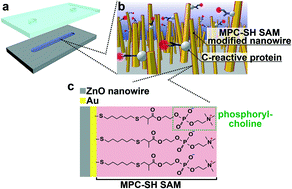Our official English website, www.x-mol.net, welcomes your feedback! (Note: you will need to create a separate account there.)
Biomolecular recognition on nanowire surfaces modified by the self-assembled monolayer†
Lab on a Chip ( IF 6.1 ) Pub Date : 2018-09-28 00:00:00 , DOI: 10.1039/c8lc00438b Taisuke Shimada 1, 2, 3, 4, 5 , Takao Yasui 1, 2, 3, 4, 5 , Asami Yokoyama 1, 2, 3, 4, 5 , Tatsuro Goda 5, 6, 7, 8 , Mitsuo Hara 2, 4, 5, 9, 10 , Takeshi Yanagida 5, 11, 12, 13, 14 , Noritada Kaji 2, 5, 12, 15, 16 , Masaki Kanai 5, 11, 12, 13 , Kazuki Nagashima 5, 11, 12, 13 , Yuji Miyahara 5, 6, 7, 8 , Tomoji Kawai 5, 14, 17, 18 , Yoshinobu Baba 1, 2, 3, 4, 5
Lab on a Chip ( IF 6.1 ) Pub Date : 2018-09-28 00:00:00 , DOI: 10.1039/c8lc00438b Taisuke Shimada 1, 2, 3, 4, 5 , Takao Yasui 1, 2, 3, 4, 5 , Asami Yokoyama 1, 2, 3, 4, 5 , Tatsuro Goda 5, 6, 7, 8 , Mitsuo Hara 2, 4, 5, 9, 10 , Takeshi Yanagida 5, 11, 12, 13, 14 , Noritada Kaji 2, 5, 12, 15, 16 , Masaki Kanai 5, 11, 12, 13 , Kazuki Nagashima 5, 11, 12, 13 , Yuji Miyahara 5, 6, 7, 8 , Tomoji Kawai 5, 14, 17, 18 , Yoshinobu Baba 1, 2, 3, 4, 5
Affiliation

|
Molecular recognition is one of the key factors in designing biosensors due to which nanowires functionalized with molecular recognition have attracted a lot of attention as promising candidates for nanostructures embedded in biosensors. However, the difficulty in real-world applications with analytical specificity is that molecular recognition on nanowires mainly depends on antibody modification with multistep modification procedures. Furthermore, the antibody modification suffers from nonspecific adsorption of undesired proteins in body fluid on the nanowires, which causes false responses and lowers sensitivity. Herein, we propose biomolecular recognition using surface-modified nanowires via thiolated 2-methacryloxyethyl phosphorylcholine (MPC-SH). MPC-SH enables self-assembled monolayer (SAM) modification, which contributes to the reduction of nonspecific adsorption of biomolecules onto the nanowires, and the specific capture of a target protein is attained in the presence of calcium ions. Our concept demonstrates the recognition of the biomarker protein on nanowire surfaces modified by MPC-SH SAM with a single step modification procedure.
中文翻译:

自组装单分子层修饰的纳米线表面上的生物分子识别†
分子识别是设计生物传感器的关键因素之一,由于分子识别功能化的纳米线作为嵌入生物传感器的纳米结构的有前途的候选物而引起了广泛的关注。然而,在现实世界中具有分析特异性的应用的困难在于,纳米线上的分子识别主要取决于采用多步修饰程序进行的抗体修饰。此外,抗体修饰遭受纳米线上的体液中不期望的蛋白质的非特异性吸附,这导致假反应并降低灵敏度。在这里,我们提出通过表面修饰的纳米线通过巯基化的2-甲基丙烯酰氧基乙基磷酰胆碱(MPC-SH)。MPC-SH可以实现自组装单层(SAM)修饰,这有助于减少生物分子在纳米线上的非特异性吸附,并且在钙离子存在下实现目标蛋白的特异性捕获。我们的概念证明了通过一步修饰程序通过MPC-SH SAM修饰的纳米线表面上生物标记蛋白的识别。
更新日期:2018-09-28
中文翻译:

自组装单分子层修饰的纳米线表面上的生物分子识别†
分子识别是设计生物传感器的关键因素之一,由于分子识别功能化的纳米线作为嵌入生物传感器的纳米结构的有前途的候选物而引起了广泛的关注。然而,在现实世界中具有分析特异性的应用的困难在于,纳米线上的分子识别主要取决于采用多步修饰程序进行的抗体修饰。此外,抗体修饰遭受纳米线上的体液中不期望的蛋白质的非特异性吸附,这导致假反应并降低灵敏度。在这里,我们提出通过表面修饰的纳米线通过巯基化的2-甲基丙烯酰氧基乙基磷酰胆碱(MPC-SH)。MPC-SH可以实现自组装单层(SAM)修饰,这有助于减少生物分子在纳米线上的非特异性吸附,并且在钙离子存在下实现目标蛋白的特异性捕获。我们的概念证明了通过一步修饰程序通过MPC-SH SAM修饰的纳米线表面上生物标记蛋白的识别。



























 京公网安备 11010802027423号
京公网安备 11010802027423号